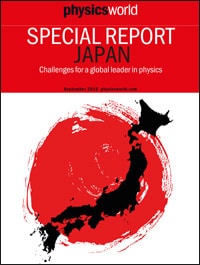By Michael Banks
Japan is certainly not resting on its laurels in maintaining its world-leading position in physics.
Only last week a Japanese government committee on high-energy physics released the English-language version of its highly anticipated report looking into the country’s particle-physics research programme for the coming decade.

The 19-member committee not only recommended that Japan should take a lead in the design for a collider to study the Higgs boson, such as the International Linear Collider, but also that it should lead on plans to build a large-scale neutrino facility to study charge–parity violations in neutrino oscillations.
It is exactly for this reason – Japan’s history as a leading nation in physics – that we decided to take a closer look at physics in the country. Not only the many successes it has enjoyed, but also what challenges it faces in staying ahead.
We’ve now put together a new Physics World special report, which you can view online here, that draws together a selection of our recent articles about physics in Japan. Several of the articles are based on a week-long road trip to Japan that I went on earlier this year that included visiting Tokyo and Osaka.
In the issue we look, for example, at a major upgrade to Japan’s famous KEKB collider, a new asteroid-sample-return mission, as well as the world’s first compact X-ray free-electron laser. But Japan also faces many challenges to its world-beating status in physics, including how to entice foreign scientists to work and study in the country as well as attracting more women into physics.
I hope you find this special report stimulating and please do let us have your comments by e-mailing pwld@iop.org.
Here’s a rundown of what’s inside.
• Recovering from the quake – I discuss how Japan’s World Premier Institutes – set up to attract international researchers – have fared following the Fukushima nuclear accident in 2011
• The only woman in town – Mio Murao of the University of Tokyo explains how to get more women interested in physics in Japan
• Japan’s X-ray vision for the future – I travel to the remote SACLA facility, which houses the world’s first compact X-ray free-electron laser
• JAXA pushes for asteroid encore – Dennis Normile looks at plans to launch a second asteroid-sample-return mission after Japan’s successful Hayabusa probe
• Getting a grip on antimatter – Yasunori Yamazaki of the RIKEN laboratory in Tokyo describes his research on antimatter
• Coping with “Galapagos syndrome” – although Japan has introduced a number of reforms to reverse a trend of increasing isolation, some fear they may not be enough, as Dennis Normile reports
• Revamping Japan’s atom smasher – with the KEKB facility in Tsukuba undergoing a major upgrade, I describe how it could one day help to explain why there is more matter than antimatter in the universe



